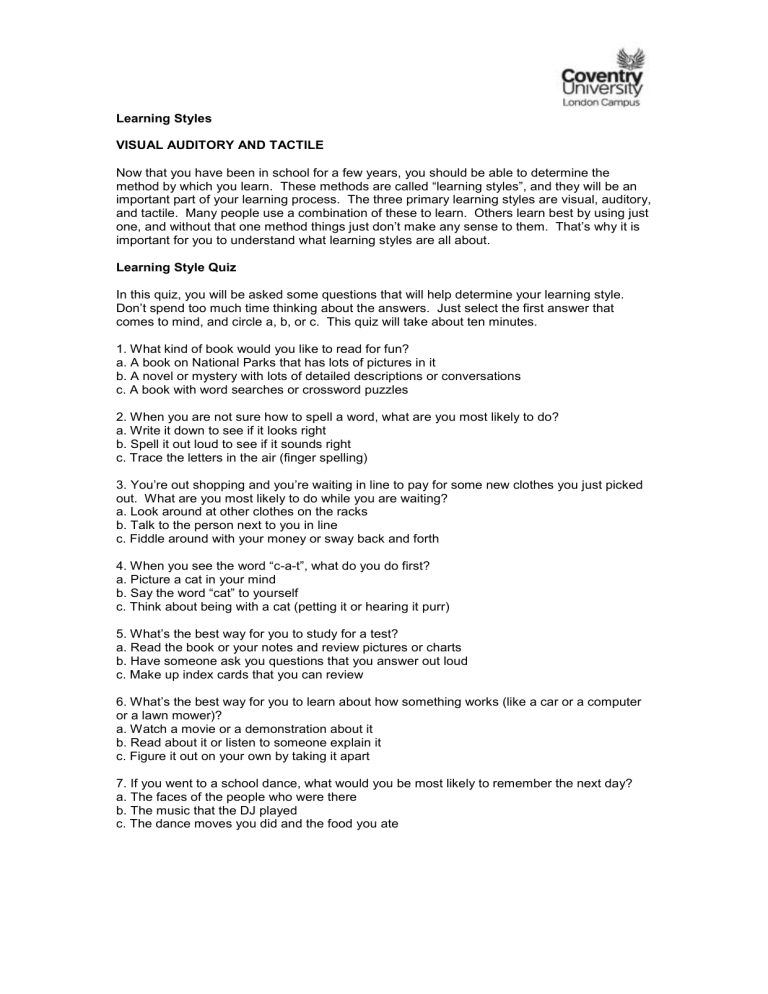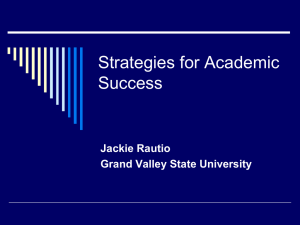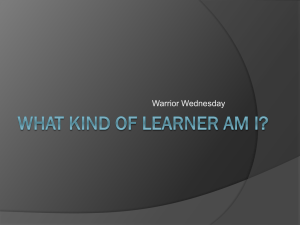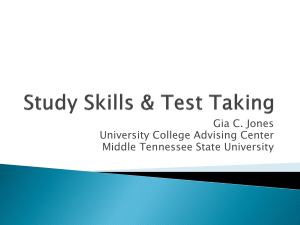302LON U1 VAK Learning Styles

Learning Styles
VISUAL AUDITORY AND TACTILE
Now that you have been in school for a few years, you should be able to determine the method by which you learn. These methods are called “learning styles”, and they will be an important part of your learning process. The three primary learning styles are visual, auditory, and tactile. Many people use a combination of these to learn. Others learn best by using just one, and without that one method things just don’t make any sense to them. That’s why it is important for you to understand what learning styles are all about.
Learning Style Quiz
In this quiz, you will be asked some questions that will help determine your learning style.
Don’t spend too much time thinking about the answers. Just select the first answer that comes to mind, and circle a, b, or c. This quiz will take about ten minutes.
1. What kind of book would you like to read for fun? a. A book on National Parks that has lots of pictures in it b. A novel or mystery with lots of detailed descriptions or conversations c. A book with word searches or crossword puzzles
2. When you are not sure how to spell a word, what are you most likely to do? a. Write it down to see if it looks right b. Spell it out loud to see if it sounds right c. Trace the letters in the air (finger spelling)
3. You’re out shopping and you’re waiting in line to pay for some new clothes you just picked out. What are you most likely to do while you are waiting? a. Look around at other clothes on the racks b. Talk to the person next to you in line c. Fiddle around with your money or sway back and forth
4. When you see the word “c-a-t”, what do you do first? a. Picture a cat in your mind b. Say the word “cat” to yourself c. Think about being with a cat (petting it or hearing it purr)
5. What’s the best way for you to study for a test? a. Read the book or your notes and review pictures or charts b. Have someone ask you questions that you answer out loud c. Make up index cards that you can review
6. What’s the best way for you to learn about how something works (like a car or a computer or a lawn mower)? a. Watch a movie or a demonstration about it b. Read about it or listen to someone explain it c. Figure it out on your own by taking it apart
7. If you went to a school dance, what would you be most likely to remember the next day? a. The faces of the people who were there b. The music that the DJ played c. The dance moves you did and the food you ate
8. When you are trying to study, what do you find to be the most distracting to you? a. People walking past you b. Loud noises c. An uncomfortable chair
9. When you are angry about something, what are you most likely to do? a. Put on your “mad” face b. Yell and scream c. Slam doors
10. When you are really happy about something, what are you most likely to do? a. Smile from ear to ear b. Talk up a storm c. Act really hyper
11. You have just gone into a big store for the first time. How do you find your way around? a. Look for a map or directory that shows where everything is b. Ask someone who works there for directions c. Just start walking around until you find what you’re looking for.
12. Of these three classes, which is your favorite? a. Art class b. Music class c. Gym class
13. When you hear a song on the radio, what are you most likely to do? a. Picture the video that goes along with it b. Sing or hum along with the music c. Start dancing or tapping your foot
14. When you’re sitting in class, what bothers you the most? a. Lights that are too bright or too dim b. Noises from the hallway or outside the building (like traffic or someone cutting the grass) c. The temperature being too hot or too cold
15. What do you like to do to relax? a. Read b. Listen to music c. Go for a walk or run
16. What is the best way for you to remember a friend’s phone number? a. Picture the numbers on the phone as you would dial them b. Say it out loud over and over and over c. Write it down on anything you can find, like the back of your hand
17. If you won a game at a carnival and you had your choice of these three prizes, which would you pick? a. Posters for your bedroom b. A CD c. A game of some kind (or a football, or a soccer ball, etc.)
18. Which would you rather go to with a group of friends? a. A movie b. A concert c. An amusement park
19. When you meet new people, what are you most likely to remember about them? a. Their face but not their name b. Their name but not their face c. What you talked about with them
20. When you give someone directions to your house, what are you most likely to tell them? a. A description of buildings and landmarks they will pass on the way b. The names of the roads or streets they will be on c. “Follow me – It will be easier if I just show you how to get there.”
All done? Now, go back over your answers and count the number of A’s,
B’s, and C’s.
Record your totals here: A’s ___ B’s ___ C’s ___
! If you have mostly A’s, you are probably a VISUAL learner. This means you learn best by seeing. Review the handout for Visual Learners for some tips on how you can become a better learner.
! If you have mostly B’s, you are probably an AUDITORY learner. This means you learn best by hearing. Review the handout for Auditory Learners for some tips on how you can become a better learner.
! If you have mostly C’s, you are probably a TACTILE learner. This means you learn best by doing. Review the handout for Tactile Learners for some tips on how you can become a better learner.
! If you have a tie between two learning styles, this means you learn in several ways. Review the handout for your blended learning style for some tips on how you can become a better learner.
Keep YOUR learning style in mind as you do homework, study for tests, and learn new material. And make sure your teachers and parents know about your learning style so they can help you learn.
VISUAL LEARNERS (Score ___ out of 20)
If you are a visual learner, you learn by reading or seeing pictures. You understand and remember things by sight. You can picture what you are learning in your head, and you learn best by using methods that are primarily visual. You like to SEE what you are learning.
As a visual learner, you are usually neat and clean, you often close your eyes to visualize or remember something, and you will find something to watch if you become bored. You may have difficulty with spoken directions, and may be easily distracted by sounds. You are attracted to color, and to spoken language (like stories) that is rich in imagery.
Did you see yourself in this description? If so, read on, because here are some things that visual learners like you can do to learn better:
Sit near the front of the classroom (it won’t mean you’re the teacher’s pet!).
Have your eyesight checked on a regular basis.
Use flashcards to learn new words.
Try to visualize things that you hear or things that are read to you.
Write down key words, ideas, or instructions.
Draw pictures to help explain new concepts, and then explain the pictures.
Color code things.
Avoid distractions during study times.
Remember that you need to see things, not just hear things, to learn well.
As you can see, people learn in different ways. And, there are many different things you can do to help yourself along the way. Now it’s up to you to play it smart and use these tips in class and when you’re studying at home. You should also make sure that your parents know about your learning style, so tell them about this exercise you did today.
Remember, knowing HOW you learn will make it easier for you to learn and remember new information for the rest of your life.
Auditory Learners (Score ___ out of 20)
If you are an auditory learner, you learn by hearing and listening. You understand and remember things you have heard. You store information by the way it SOUNDS, and you prefer listening over reading and writing. You often learn by reading out loud because you have to hear it or speak it in order to know it.
As an auditory learner, you probably hum or talk to themselves or others if you become bored. Sometimes people think you are not paying attention, even though you may be hearing and understanding everything being said. You have an easier time understanding spoken directions or instructions than ones that are written down.
Does this sound like you? If so, read on, because here are some things that auditory learners like you can do to learn better:
Be sure you sit where you can hear.
Have your hearing checked on a regular basis.
Use flashcards to learn new words, but read them out loud.
Read stories, assignments, or directions out loud.
Tape yourself practicing spelling words and then listen to the tape.
Have test questions read to you out loud.
Study new material by reading it out loud.
Remember that you need to hear things, not just see things, in order to learn well.
As you can see, people learn in different ways. And, there are many different things you can do to help yourself along the way. Now it’s up to you to play it smart and use these tips in class and when you’re studying at home. You should also make sure that your parents know about your learning style, so tell them about this exercise you did today.
Remember, knowing HOW you learn will make it easier for you to learn and remember new information for the rest of your life.
Tactile Learners (Score ___ out of 20)
If you are a tactile learner , you learn by touching and doing. You understand and remember things through physical movement. You are a “hands-on” learner who prefers to touch, move, build, or draw what you learn, and you tend to learn better when some type of physical activity is involved. You need to be active and take frequent breaks, you often speak with your hands and with gestures, and you may have difficulty sitting still.
As a tactile learner, you like to take things apart and put things together, and you tend to find reasons to tinker or move around when you become bored. You may be very well coordinated and have good athletic ability. You can easily remember things that were done, but might have difficulty remembering what you saw or heard in the process. You often communicate by touching, and you appreciate physically expressed forms of encouragement, such as a pat on the back.
Does this hit the nail on the head? If so, read on, because here are some things that tactile learners like you can do to learn better:
Participate in activities that involve touching, building, moving, or drawing. - Use lots of hands-on activities like art projects, taking walks, or acting out stories.
It’s OK to chew gum, walk around, or rock in a chair while reading or studying.
Use flashcards and arrange them in groups to show relationships between ideas.
Trace words with your finger to learn spelling (finger spelling).
Take frequent breaks during reading or studying periods (frequent, but not long).
It’s OK to tap a pencil, shake your foot, or hold on to something while learning.
Use a computer to reinforce learning through the sense of touch.
Remember that you learn best by doing , not just by reading, seeing, or hearing.
As you can see, people learn in different ways. And, there are many different things you can do to help yourself along the way. Now it’s up to you to play it smart and use these tips in class and when you’re studying at home. You should also make sure that your parents know about your learning style, so tell them about this exercise you did today.
Remember, knowing HOW you learn will make it easier for you to learn and remember new information for the rest of your life.
Visual/Auditory Learners (Score ___ out of 20)
You are a visual/auditory learner. This means you have traits of both visual learners and auditory learners. In other words, you learn by seeing and by hearing. You can picture things in your mind, but you also remember things by how they sound.
You may find that the learning style you use will depend on the subject matter you are studying. For example, in math you may learn visually by writing things down, while in history you may learn by listening or reading out loud. It will become important for you to understand which learning style works best for you in each subject area.
Here are some things that visual/auditory learners like you can do to learn better:
Be sure you sit where you can see and hear well.
Have your eyesight and hearing checked on a regular basis.
Determine which subject matter you can better learn by seeing. In these subjects, try to visualize things you hear or things that are read to you, and write down key words, ideas, or instructions.
Determine which subject matter you can better learn by hearing. In these subjects, read stories, assignments, or directions out loud.
Use flashcards to learn new words or concepts, and read them out loud if you find it helpful.
Color code things if that helps you visualize ideas or concepts.
Avoid distractions during study time. You are likely to be distracted by sights or sounds or both, so find a quiet place to study.
Remember that you learn best by seeing and hearing.
As you can see, people learn in different ways. And, there are many different things you can do to help yourself along the way. Now it’s up to you to play it smart and use these tips in class and when you’re studying at home. You should also make sure that your parents know about your learning style, so tell them about this exercise you did today.
Remember, knowing HOW you learn will make it easier for you to learn and remember new information for the rest of your life.
Visual/Tactile Learners (Score ___ out of 20)
You are a visual/tactile learner. This means you have traits of both visual learners and tactile learners. In other words, you learn by seeing and by doing. You can picture what you are learning in your mind, but you also learn by touching, moving, drawing, or building as you learn.
You may find that the learning style you use will depend on the subject matter you are studying. For example, in math you may learn visually by writing things down, while in science you may learn by doing hands-on experiments or activities. It will become important for you to understand which learning style works best for you in each subject area.
Here are some things that visual/tactile learners like you can do to learn better:
Be sure to sit where you can see well.
Have your eyesight checked on a regular basis.
Use flashcards to learn new material, and arrange them in groups to show relationships between ideas.
Try to visualize things that you hear or things that are read to you.
Use hands-on activities to better understand things you have seen.
Write down key words, ideas, or instructions.
Draw pictures to help explain or understand new concepts.
Take frequent breaks (but not long breaks) during reading or study periods.
Stay active when you read or study at home. Tap a pencil, chew gum, shake your foot, walk around, rock in a chair – but try to avoid distractions.
Use a computer to reinforce the learning process.
Remember that you learn best by seeing and doing.
As you can see, people learn in different ways. And, there are many different things you can do to help yourself along the way. Now it’s up to you to play it smart and use these tips in class and when you’re studying at home. You should also make sure that your parents know about your learning style, so tell them about this exercise you did today.
Remember, knowing HOW you learn will make it easier for you to learn and remember new information for the rest of your life.
Auditory/Tactile Learners (Score ___ out of 20)
You are an auditory/tactile learner. This means you have traits of both auditory learners and tactile learners. In other words, you learn by hearing and by doing. You understand and remember things you have heard, but you also learn by touching, moving, drawing, or building as you learn.
You may find that the learning style you use will depend on the subject matter you are studying. For example, in history you may learn by listening or by reading out loud, while in science you may learn by doing hands-on experiments or activities. It will become important for you to understand which learning style works best for you in each subject area.
Here are some things that auditory/tactile learners like you can do to learn better:
Be sure to sit where you can hear well.
Have your hearing checked on a regular basis.
Use flashcards to learn new material. Arrange the cards in groups to show relationships between ideas, and then read them out loud.
Use hands-on activities to better understand things you have learned.
Read stories, assignments, or directions out loud.
Tape-record yourself practicing spelling, vocabulary or other questions, and then listen to the tape.
Take frequent breaks (but not long breaks) during reading or study periods.
Stay active when you read or study at home. Tap a pencil, chew gum, shake your foot, walk around, rock in a chair – but try to avoid distractions.
Use a computer to reinforce the learning process.
Remember that you learn best by hearing and doing.
As you can see, people learn in different ways. And, there are many different things you can do to help yourself along the way. Now it’s up to you to play it smart and use these tips in class and when you’re studying at home. You should also make sure that your parents know about your learning style, so tell them about this exercise you did today.
Remember, knowing HOW you learn will make it easier for you to learn and remember new information for the rest of your life.







